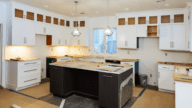How Much Does It Cost to Add a Window to Your Home?
- Published on
- 5 min read
-
 Jael Batty, Contributing AuthorClose
Jael Batty, Contributing AuthorClose Jael Batty Contributing Author
Jael Batty Contributing AuthorJael Batty is a freelance writer with 23+ years of marketing experience. Her expertise includes marketing and writing content for solar installers, electrical service providers, HVAC contractors, landscapers, and tile installers. Over her lifetime, she has lived in six states, moved 17 times, bought three houses, and sold two.
-
 Sam Dadofalza, Associate EditorClose
Sam Dadofalza, Associate EditorClose Sam Dadofalza Associate Editor
Sam Dadofalza Associate EditorSam Dadofalza is an associate editor at HomeLight, where she crafts insightful stories to guide homebuyers and sellers through the intricacies of real estate transactions. She has previously contributed to digital marketing firms and online business publications, honing her skills in creating engaging and informative content.
Homeowners often consider adding windows to improve their living spaces, and for good reason.
A well-placed window brings in natural light, opens up views, and can make any room feel larger and more inviting. Beyond aesthetics, it’s also a functional improvement, offering better ventilation. However, many homeowners are concerned about the cost to add a window to an existing wall.
How much you’ll actually pay to add a window depends on the size and type of window you install, the contractor you choose, and the difficulty of the job. But if you are making plans to sell your property, adding natural light to a dim room may add scale-tipping appeal to your home.
To give you the most current costs and value adds, we spoke with top real estate agent Sandi Van Camp, who works with 82% more single-family homes than her peers in Canandaigua, New York, and consulted with the Pella Corporation, which has manufactured window products since 1925.
Window addition cost overview
While window replacements typically cost between $300 and $1,650, new construction windows are more expensive due to the need for framing, siding, finishing work, and potentially rerouting plumbing or electrical lines. Installing a completely new window can cost as much as $5,000 per window.
The average labor cost for the project ranges from $100 to $400 per window, or approximately 15% of the total project cost. The type, size, and material of the actual window likewise influence the total cost of the project.
Methodology: HomeAdvisor tracks millions of user-submitted project estimates and correlates them with local professional estimates to deliver accurate averages.
Real-life cost to add a window
Because there are so few online resources that list the current cost to add a window to an existing wall, we spoke with Pella Public Relations and Brand Communications Manager Nicolle Picray.
According to Picray, you can get a window estimate on the Pella website. However, she warns that homeowners should exercise caution when budgeting a window remodel based only on their online costs. Pella’s window estimator is really a tool designed for installers more than homeowners.
All Pella windows are custom-made, and prices are difficult to estimate without details about your location and project. Instead, homeowners should contact a local Pella rep for accurate pricing and recommendations.
Pella online example prices for double-pane vinyl-frame windows
| Window type | Cost in California |
| Casement window | $810.35 |
| Single-hung window (vinyl) | $426.82 |
| Double-hung window (wood) | $1,013.22 |
| Awning window (wood) | $907.62 |
| Sliding window (vinyl) | $517.34 |
As mentioned, you need to cover labor costs, as well as expenses for rerouting any wiring and for the materials needed to repair and finish the wall around the window. We break down these costs below.
Major cost factors to consider
As illustrated above, what a homeowner might expect to pay to add a window to an existing wall can fall in a broad range because every project is different. The final cost depends on a number of factors beyond just the price of the window itself.
Picray emphasizes that a window is only as good as the installation. Improper installation can result in low window efficiency and difficulty opening and closing moving sashes.
Some of the expenses involved in putting a window into an existing wall include:
- Labor and installation: $100 and $400 per window
- Framing: $785-$1,228
- Drywall repair: Starts at $50 per square foot
- Siding repair: Starts at $2 per square foot
- Insulation: Starts at $29 per window
Other cost considerations include:
- Whether the wall is load-bearing or gabled, (triangular)
- Whether there is plumbing in the wall
- Whether the exterior and interior walls are accessible
- Whether the window will be installed on a second level, requiring scaffolding and safety harnesses
- Whether the window will be installed in a basement
- Whether your home is located in a high altitude location, requiring windows that can withstand the pressure
- Whether your windows will need to withstand extreme heat or extreme cold
Additional cost contributors
In addition to the hardware and installation, the price of a window will vary depending on the style you want, how it opens, the frame material, and its insulation (the number of panes of glass).
Window cost by style: $400 to $2,500
The factors that affect how much you’ll pay are the design of the window and the materials used. Most of these example window designs below are available in a variety of materials. According to HomeAdvisor, these are the costs for different style windows:
- Single-hung: $400. The bottom sash of a single-hung moves up and down while the top sash is fixed.
- Double-hung: $700. A double-hung window has top and bottom sashes that move up and down. The sashes on some of the more expensive double-hung windows also tilt inward for easier cleaning.
- Casement: $900. A casement window cranks open from one side or the other and can be opened fully for ventilation or egress (escape in an emergency).
- Sliding: $1,000. One or both of the sashes slide from side to side rather than up and down.
- Egress: 2,300. An egress window is designed to allow escape in an emergency, such as a fire or natural disaster. They are most commonly added to bring basement bedrooms up to code.
- Bay: $2,500. A bay window is actually three windows. It consists of a large stationary picture window in the center and two smaller windows, one on either side. The side windows may be sash or casement windows.
Window cost by pane: $450-$3,100
The number of panes of glass in a window affects its insulation, soundproofing, and cost. Here’s an overview of what you can expect to pay for different types of glass, according to HomeAdvisor:
- Double: $450-1,000. A double-pane window is made of two panes of glass separated by a spacer. Air or gas between the two panes holds the glass in place, provides insulation, and acts as a sound barrier. Double-pane windows can last eight to 20 years.
- Triple: $500-$2,000. A triple-pane window is similar to a double-pane window except that it has three panes of glass separated by spacers. They are stronger, more energy-efficient, and more soundproof than double-pane windows.
- Low-E coating: $600 to $3,100. The transparent coating on these windows reflects solar heat, making them more energy-efficient, especially in warm climates.
Window cost by frame: $550–$1,250
The frame you choose will affect the cost of your window, its durability and insulation, the amount of maintenance required, and, most importantly, its look on your home.
- Vinyl: $550.Vinyl-framed windows are low-maintenance and durable. They don’t swell or shrink when the humidity changes. They come with warranties, some as long as a lifetime. Although they’re not as aesthetically appealing as wooden frames, the price point and warranties make them popular.
- Fiberglass: $1,100. A fiberglass frame is more durable than vinyl and can last up to 50 years. However, it is higher maintenance than vinyl and can fade or peel over time. The high cost makes it less common to install in a home.
- Wood: $1,250. Wooden frames offer an authentic aesthetic with a traditional look that is more attractive than vinyl or fiberglass. The wooden frame is an ideal insulator for hot or cold weather. They require regular maintenance, such as painting and finishing, to protect the frame from the elements.
Window cost by size: $400-$2,500
The cost of your new window will increase the larger your window gets.
- Living room size: $900 for a picture window. A dim living room is not a happy space. The size of the window you choose depends on your wall space, the size of the glass, the exterior view, and the amount of light you want in your space.
Picture windows are the most common choice for the living room and come in many sizes and styles, including borderless. They range in size from 12 to 96 inches tall and 24 to 96 inches wide.
- Bathroom size: $1,000-$2,500 for sliding and bay windows. The number of windows you add to your bathroom depends on the available space, the view, the amount of sunlight you prefer, and the level of privacy you need.
If you prefer a sliding window, you can expect to pay about $1,000. The standard size ranges from 26 to 84 inches wide and 24 to 60 inches tall. Meanwhile, if you opt for a bay or bow window, the cost is $2,000.
- Hallway size: $400 for a single-hung window. A standard single-hung window is most common in the hallway. The size you choose depends on the size of the exterior wall in your hallway and the amount of natural light you want for this space. They range from 36 to 84 inches wide and 24 to 60 inches tall.
Other ways to add light to your home
A window isn’t the only way to bring natural light into your home. If you’re interested in exploring all your options, consider:
Skylight: $800-$2,500. Don’t be afraid to add a skylight, says Van Camp. When they’re installed correctly, they’re a fabulous way to add light to a dark room.
Light tube: $600-$1,000. Also known as a solar tube, a sun tunnel, or a solar skylight, this is a metal tube that extends from your roof to the ceiling below. It has a weather-resistant acrylic cap on the outside and a diffuser on the inside that distributes light evenly.
A light tube is a great way to add daylight to a small or dim space. A 10-inch tube can illuminate a 200-square-foot space, while a 14-inch tube can light a 300-square-foot area.
Window wall: $200–$2,900 per linear foot for windows and installation and $1,000–$3,000 for a door. Also known as a curtain wall or ribbon window, a window wall is a large section of glass installed between the floor and ceiling. It is thicker and stronger than a standard window and requires additional structural support.
Will adding a window to an existing wall increase home value?
According to Van Camp, bringing natural light into your home always adds appeal. To maximize the appeal, consider what kind of view the window will add. A garden or lake view adds aesthetic appeal. However, adding the view of a street, driveway, or view into the neighbor’s bathroom is a bit less appealing.
Also, consider your climate when adding a window. South-facing windows bring in cozy natural light in colder climates, whereas north-facing windows are a better value-add in warm southern climates.
Van Camp explains that “appeal” may translate into return on investment (ROI) or strengthen your position on your asking price. However, since windows don’t change a home’s square footage, and don’t necessarily count the same in an appraisal the way other upgraded features might, it’s difficult to estimate how additional or improved windows will move the ROI needle.
If maximizing the value of your home is your ultimate goal, Van Camp recommends replacement windows. Replacing drafty, inefficient windows is one of the best ways to add value to your home. For more information, check out our article detailing how much you’ll pay for replacement windows and how much of the cost you’ll recoup.
Header Image Source: (Roberto Nickson / Unsplash)
- "What Is the Average Cost to Install Windows in 2024?," HomeAdvisor (September 2024)
- "How Much Does It Cost To Frame A Window Opening?," Porch (August 2024)
- "How Much Does Drywall Repair Cost? [2025 Data]," Angi, Lauren Bongard (December 2024)
- "How Much Does It Cost to Repair Siding? [2025 Data]," Angi, Haniya Rae (December 2024)
- "Solar Tubes vs. Skylights: Solar Tubes Win for Low-Cost Daylighting," Houselogic (September 2022)
- "How Much Does a Glass Window Wall Cost in 2024?," HomeAdvisor (August 2024)




